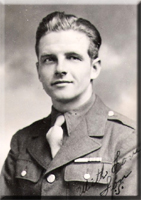
Frank Vandenberg's Story ...
Frank Vandenberg's story starts in a little town named Phelps. His parents Cornelius Vandenberg and Anna (Klooster) Vandenberg, brothers and sisters lived there until Frank was six years old. Phelps was a little town on the railroad, between Charlevoix and Ellsworth. When Frank was six years old they moved about two miles east of Phelps on a 1000-acre ranch.
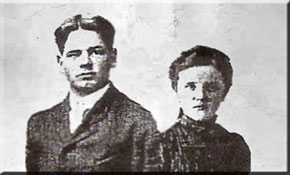
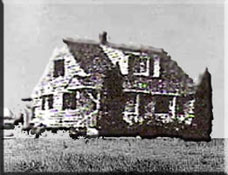
Frank's parents Cornelius and Anna & Frank's first home in Phelps
Frank's roots can be traced back to Gelderland in the Netherlands. The family on his father's side, the Vandenberg-family probably migrated to the United States somewhere in the 1850's. The family on his mother's side, the Klooster-family migrated to the United States in 1897. Frank grew up with six brothers and sisters ... Grace, John, Jacob, Effie, Ed and Iola.
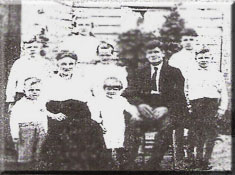
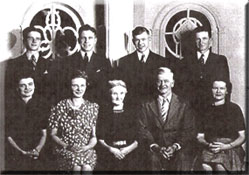
Frank's family in the early years & many years later
in the right picture, Frank is in the backrow on the left
In 1937 Frank graduated from the 12th grade of East Jordan High School. Until 1940 Frank worked with his brothers and sisters on the ranch of his mam and dad. After that he went to Detroit Michigan, where he started working for the Detroit Lumber Company until he was drafted in 1941 ...

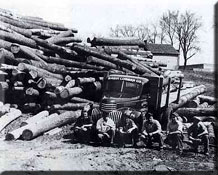
Working in a Lumber Company ... before being drafted
By the time John was 24 years old, he was drafted in the United States Army. He received an order to report for induction at Fort Custer, Michigan. Frank was accepted for active military service on February 18, 1941. From this day on Frank was being prepared for just one thing ... the invasion of Europe on 6 June, 1944 ... D-Day. At that time no one knew, the attack on Pearl Harbor was still months away and the United States were not at war ... yet.
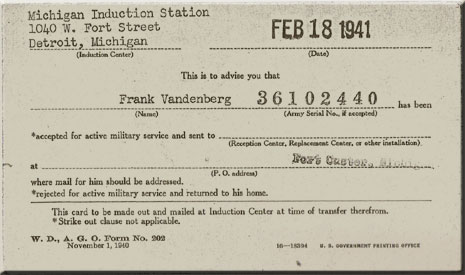 the form states that Frank has been accepted in the Army
the form states that Frank has been accepted in the ArmyIn the beginning of his Army-carreer, Frank was attached to the 30th Infantry Division, the Old Hickory Division. This division would later in the war fight it's way through France, Belgium, the Netherlands and of course Germany. Frank's name shows up on a Christmas
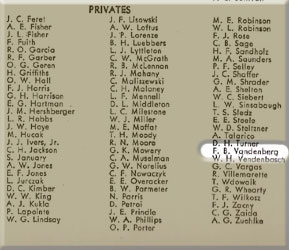 the roster with Privates of the 30th Infantry Division
the roster with Privates of the 30th Infantry DivisionFrank's later outfit, the 1st Infantry Division, nickname the Big Red One, entered World War II at Oran, North Africa, as part of the "Torch" Invasion, the first American campaign against Germany. On Nov. 8,1942, following training in the United Kingdom, men of the First Division landed on the coast of Algeria near Oran. The initial lessons of combat were harsh and many men were casualties in the following campaign in Tunisia.
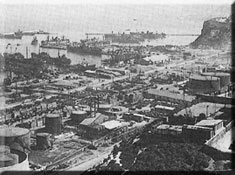
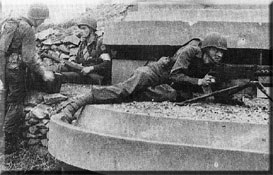
the Port of Oran (left) & fighting troops in Oran
November 8, 1942 - the landing in North-Africa
On May 9, 1943, the commander of the German "Afrika Korps" surrendered his force of 40,000. The Division then moved on to take Sicily in "Operation Husky." The 1st Division stormed ashore at Gela, July 10, 1943, and quickly overpowered the preliminary Italian defenses. Soon after, the Division came face-to-face with 100 tanks of the Herman Goering Tank Division. With the help of naval gunfire, its own artillery and Canadian allies, the First Infantry Division fought its way over the island's hills, driving the enemy back. The Fighting First advanced on to capture Troina and opened the Allied road to the straits of Messina.
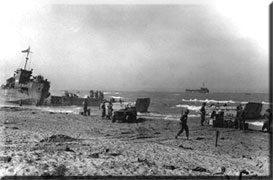
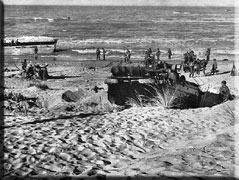
the landing on Gela Beach during Operation Husky
July 10, 1943 - the landing on Sicily, Italy
Since as long ago as 1942, the Allies had been planing for an invasion of Hitler's Europe. It began with the appointment of General Dwight D. Eisenhower, a strong and highly capable commander who was liked immensely by his peers, as well as a new headquarters staff, SHAEF (Supreme Headquarters Allied Expeditionary Force). The preparation for D-Day was on it's way ...
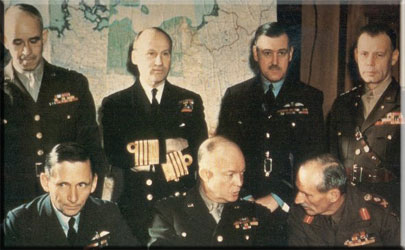
SHAEF ... frontrow (left to right): Tedder, Eisenhower, Montgomery
backrow (left to right): Bradley, Ramsay, Leigh-Mallory, Bedell-Smith
The selection of a site for the invasion was critical to its success and was perhaps the Allies biggest advantage, since the Germans were forced to guess as to the location of the site and therefore had to defend everywhere, thus not completely defending anything, to paraphrase Frederick the Great, The weather, the moon, and the tides were some of the biggest factors in the selection. The weather had to be moderately calm, the moon had to be at least half-full the night before so the paratroopers could work effectively, the tide had to be low and rising to expose all of the beach obstacles and the date had to be after June 1st, so that enough transport ships could get over from the States to make the assault effective and to allow the troops another month of training. These factors all came together during five days in June, the 5th, 6th, 7th, 19th and 20th. Eisenhower then decide June 5th would be the date with H-Hour slated for dawn, which was about 0630 in the morning.
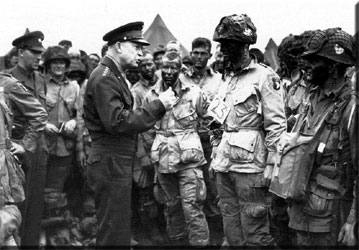
General Eisenhower talking to paratroopers of the 101st Airborne Division
The most logical site for the invasion, a site that met all requirements was Pas-de-Calais, which is very close to the airfields in Kent and not far from the English seaports. This choice was also the most illogical because the Germans had made this the only finished portion of the Atlantic Wall at that point and armed it with very heavy guns. The Allied planners then looked to the north and found only the easily-flooded regions of Flanders. When they looked to the south they found the less heavily defended regions of Normandy and Cotentin. The Contentin peninsula was too narrow and easily flooded as well as having unsheltered beaches for the Allied planners liking. Therefore, Normandy and the nearby city of Caen were selected as the site of the invasion.
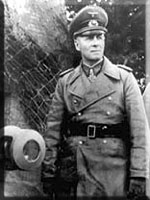
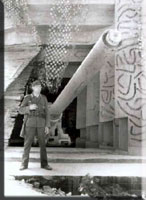

Feldmarschall Erwin Rommel & German soldiers guarding the Atlantikwall
Frank and his buddies conducted some of the most realistic training ever done in the history of war for the Overlord invasion. Large areas of the British Isles became restricted as the armies trained on their cliffs, harbors, beaches, and forests. Because of how realistic the locations of the training were, it was important that no German reconnaissance boats or planes sneak in and learn what the Allied targets looked like, which would have given them a clue as to where the attack would take place.

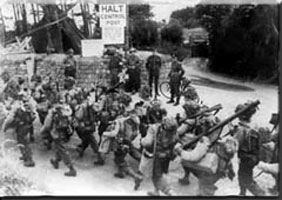
Troops training for the Overlord Invasion
On D-Day, June 6,1944, the Big Red One stormed ashore at Omaha Beach. Soon after H-Hour, the Division's 16th Regiment was fighting for its life on a strip of beach near Coleville-sur-Mer that had been marked the "Easy Red" on battle maps. Together with thousands of other soldiers the men of the 16th Infantry Regiment assaulted the beaches in the early hours of June 6, 1944 ...


Soldiers in LCT's heading for their assault on Omaha Beach
Within two hours, the decimated unit huddled behind the seawall. The beach was so congested with the dead and dying, there was no room to land reinforcements. Colonel George Taylor, commander of the 16th Infantry Regiment, told his men, "Two kinds of people are staying on this beach! The dead and those who are going to die! Now, let's get the hell out of here!"
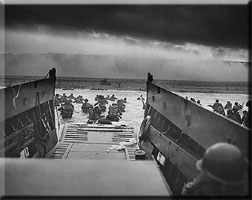

the landing on Omaha Beach & the staff of the 16th Infantry
Regiment
(Col. George Taylor, Comm. 16th Infantry Regiment on the left of the right photo)
Frank's company G was scheduled for the infantry assault wave following Company E and F at H+30 minutes to land on EASY RED. They were loaded from USS HENRICO into assault craft at 0415 hours, rendezvoused 500 yards off the starboard bow until 0445 hours, then proceeded toward the beach. One of the craft capsized 200 yards from the beach, forcing the boat teams to swim ashore minus key equipment and weapons; remainder of the company walked ashore in the face of heavy enemy fire. The number of casualties mounted.
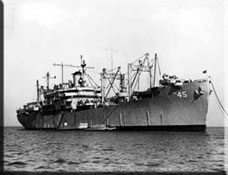
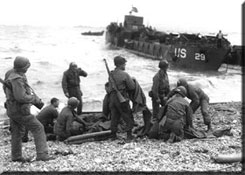
the troopship USS Henrico & First aid for survivors of a sunken LST on D-Day
Approximately 200 yards inland from a waterline a small shingled mound about 10 feet high enabled the company to secure a slight amount of defilade from fire raking the beach from the flanks and immediate front. Company G found a large number of troops, who had landed at H-hour, pinned down on the beach unable to advance into the bluff overlooking the beach. Company G found most units disorganized due to loss of officers and NCO's on the beach.
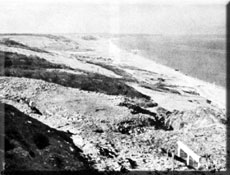
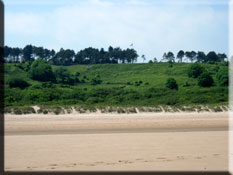
Omaha Beach in 1944 & Omaha Beach 61 years later ...
A hasty reorganization of assault teams was made in Company G and 60mm mortars and MGs were placed in firing position. All efforts were made by a few officers and NCOs to build up a volume of fire. A few elements of the 1st wave, by this time had succeeded in advancing approximately 100 yards in front of this position but were pinned down and unable to move in any direction because of enemy fire concentration.
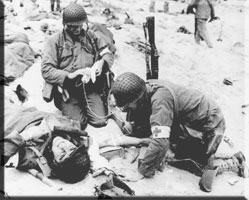

Medics treating a wounded soldier & Wounded men of the 16th Infantry Regiment
At 0710 hours G Company infiltrated through a narrow gap between minefields flanked by the shingle mound and overlooking a cliff. Lt Spaulding's section, Company E, and remnants of two sections from Company E, 16th Infantry, were pinned down at the base of the cliff. They were told by the Company Commander of G Company that their organizations were supposed to be 500 yards to the right of this position and to move inland and to the right if possible. They proceeded to move forward and slightly to the right. As Company G reached this point the sections were directed to seize high ground to the immediate front and to deploy from right to left as they cleared the crest of the hill, in addition to maintaining contact with two sections of Company E on the right.
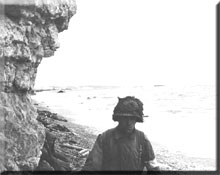
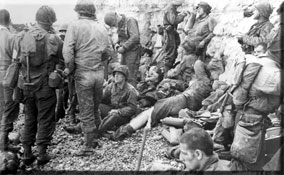
a 16th infantry medic & 16th Infantry soldiers take a
"breather" before moving on
both pictures taken on Omaha Beach
In the following days the Allied forces were able to maintain and expand the beach head. D-Day marked the beginning of the end of the German Reich of Adolf Hitler ... Freedom would be established by these brave men and women who attacked these foreign beaches. It would take another 11 months before Nazi Germany was defeated ... And while ending Frank Vandenberg's story I can't help thinking of Colonel George Taylor's words on that fateful day ... "Two kinds of people are staying on this beach! The dead and those who are going to die!" ... Frank and a lot of his comrades stayed on that beach ...
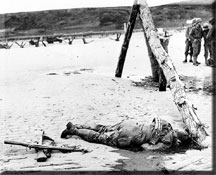

"Two kinds of people are staying on this beach!
The dead and those who are going to die!"
After Frank had been killed, he was buried at the temporary cemetery of Saint Laurent, Bayeux. Frank was laid to rest in Plot G, Row 1, Grave 16 ... On his right side was buried J. A. Martin whose outfit remains unknown. On his left Anthony P Pfeifer from the 23rd Infantry Regiment, 2nd Infantry Division. Anthony Pfeifer is still in Normandy ... He found his final resting place in Plot I, Row 21, Grave 7, only 5 rows away from Frank's final resting place ... J.A. Martin probably has been returned to the United States ...
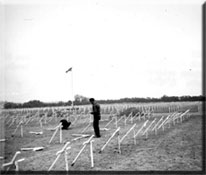
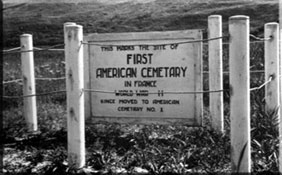
placing crosses at Omaha Beach & the First American Cemetery
in Europe
the cemetery has been moved to American Cemetery No 1
(Normandy ... Colleville-sur-Mer)
In 1947 Frank and his buddies were moved to their final resting place at Colleville-sur-Mer ... a cemetery overlooking the sands of Omaha beach ... The same beach they assaulted only three years earlier on D-Day. A day that will live on forever together with their names, their legacy, their memory ...
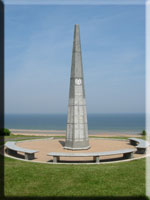
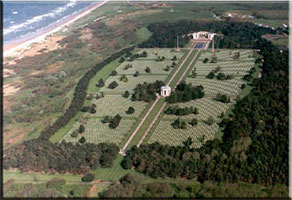 the 1st Inf Div Memorial & Normandy Cemetery overlooking Omaha Beach
the 1st Inf Div Memorial & Normandy Cemetery overlooking Omaha BeachFrank's final resting place is in the Plot on the right bottom corner
These days Frank B Vandenberg rests in the beautiful American Military Cemetery on top of the cliffs overlooking Omaha Beach, Normandy in Colleville- sur-Mere. He is remembered and honored by his brother Jacob, by his entire family, by Vincent Vandeberg who adopted his final resting place at Normandy, by every visitor of the American Cemetery Normandy and by every visitor of the In Honored Glory website.
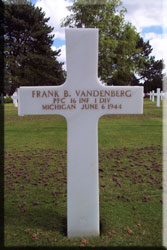 Frank Vandenberg's final resting place in Normandy
Frank Vandenberg's final resting place in NormandySpecial thanks to Frank's brother Jacob, to the entire Vandenberg family and to Vincent Vandeberg who adopted Frank's final resting place in Normandy
published August 2, 2006